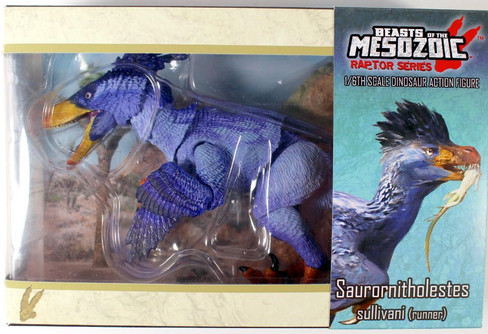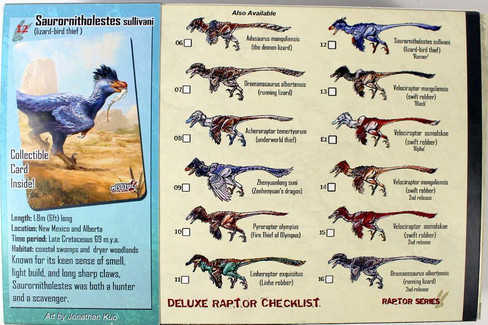Beasts of the Mesozoic Saurornitholestes sullivani Runner
Beasts of the Mesozoic Saurornitholestes sullivani Runner Manufacturer Information:
Saurornitholestes sullivani 1/6 Scale Dinosaur Figure
(lizard-bird thief )- Known for its keen sense of smell, light build, and long sharp claws, Saurornitholestes was both a hunter and a scavenger.
Each deluxe raptor figure is approximately 12? long x 5? tall has 26 points of articulation and includes one base, multiple posing rods and attachments, two interchangeable head crests, optional closed running toes, collectible trading card, unique background display insert and instruction sheet. Packaging features red-foil printing and art by Jonathan Kuo.
Recommended for ages 15 and up (contains small parts)
Saurornitholestes sullivani Information:
Saurornitholestes sullivani is an extinct species of theropod dinosaur that belonged to the family Dromaeosauridae. These dinosaurs are commonly known as "raptors," and they were small to medium-sized, carnivorous dinosaurs that lived during the Late Cretaceous period, approximately 75-70 million years ago.
Here is some information about Saurornitholestes sullivani:
Discovery and Name: The first fossils of Saurornitholestes sullivani were discovered in the Dinosaur Park Formation of Alberta, Canada. The species was named in 1978 by Philip J. Currie, a Canadian paleontologist, who chose the name "Saurornitholestes" from Latin words meaning "lizard-bird robber" due to its presumed bird-like appearance and carnivorous diet. The species name "sullivani" honors J.P. Sullivan, who played a key role in the early development of dinosaur research in Alberta.
Size and Physical Characteristics: Saurornitholestes was a relatively small dinosaur, measuring about 1.2 to 2 meters (4 to 6.5 feet) in length and standing about 0.6 meters (2 feet) tall at the hip. It had a slender body with long, thin legs and a long, stiff tail that likely helped with balance and agility. Its arms were equipped with sharp claws, and it is believed to have had a feathered covering, typical of many theropod dinosaurs.
Carnivorous Diet: As a member of the Dromaeosauridae family, Saurornitholestes was a carnivorous predator. It had sharp, serrated teeth that were ideal for slicing through flesh, and its agile and lightweight build likely allowed it to be a swift hunter.
Behavior and Habitat: Saurornitholestes is believed to have been an active predator that used its speed and intelligence to hunt small vertebrates and insects. It likely lived in a variety of environments, including forested areas and open plains.
Relationship to Other Dinosaurs: Saurornitholestes is closely related to other dromaeosaurids such as Deinonychus and Velociraptor. These dinosaurs shared many physical features, including the distinctive enlarged claw on the second toe of each foot, which was used in hunting and possibly for climbing.
Feathers and Potential Warm-Bloodedness: The presence of feathers in some closely related dromaeosaurid dinosaurs suggests that Saurornitholestes likely had a feathered covering as well. Furthermore, some researchers have proposed that dromaeosaurids, including Saurornitholestes, might have exhibited behaviors associated with warm-blooded animals, such as active hunting and possibly even parental care.
It's worth noting that our understanding of dinosaurs is constantly evolving as new discoveries are made and ongoing research sheds light on their biology, behavior, and ecology. The information provided here is based on the knowledge available up to September 2021.
Hand Painted. Product Material: PVC
Product Code: #52412by Beasts of the Mesozoic














